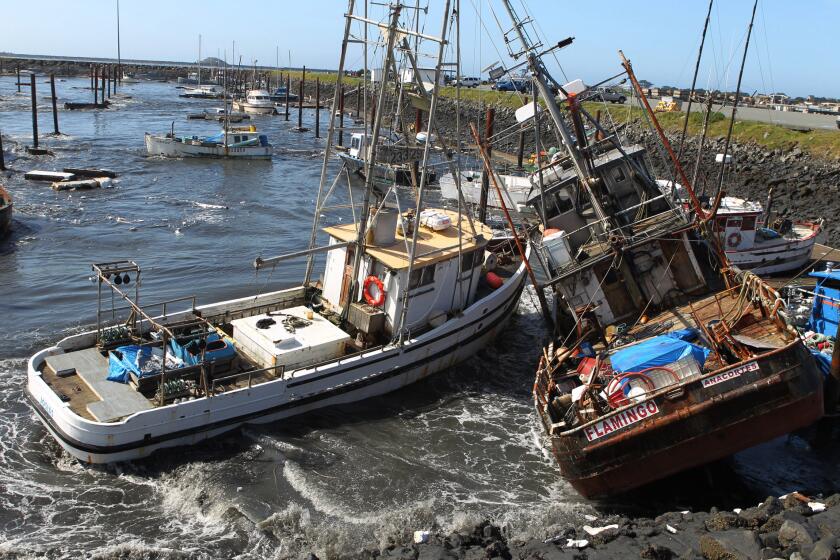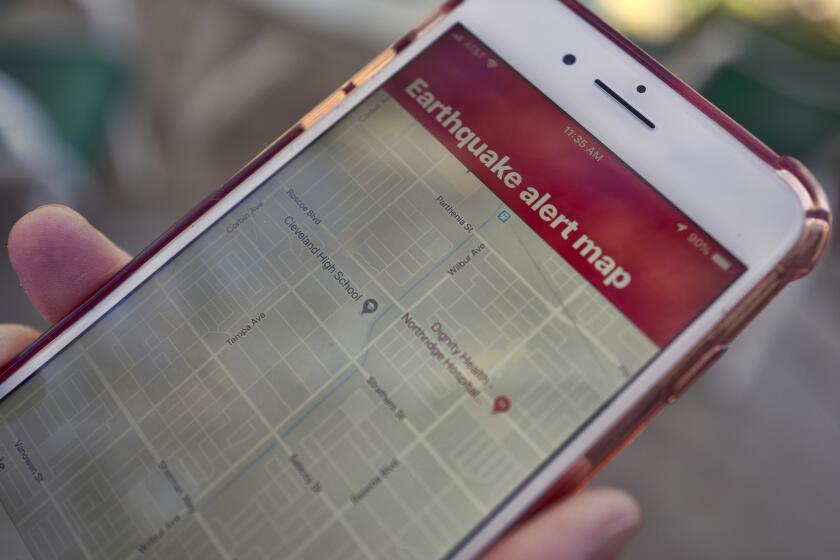Earthquake: Diaster Before Dawn : Slide Anniversary Footnotes Quake : Disasters: Anaheim Hills residents are edgy. Two years in a row, Martin Luther King’s Birthday accompanies ravages of nature.
- Share via
ANAHEIM — For Anaheim Hills residents, Monday’s earthquake brought unsettling memories of Martin Luther King Day Jr. last year, when another natural disaster struck.
“What is it with this day?” asked Anaheim Hills resident Sally Fields. “First it was the landslide and now this.”
Even the city’s spokesman seemed troubled by the coincidence. “We’re not looking forward to next year’s,” said Bret Colson.
Although Anaheim escaped from the quake relatively unscathed Monday, residents in the hills are still reeling from the landslide, which officially marks its one-year anniversary today.
The signs of chaos and destruction from the 25-acre slide are all but gone. Streets have been repaved, homes have been patched and, most important, the hillside has stopped moving.
But all is not normal in these scenic neighborhoods.
In fact, life for many of the residents is still as uncertain as the ground they live on. They pray for clear skies, fret about watering their lawns too much and are acutely aware of every creak and crack in their homes.
“I don’t know if we’ll ever feel completely safe,” said Gail Turner, who, like 48 other homeowners, was evacuated after weeks of rain soaked the hills and reactivated an ancient landslide. “Every time you hear a creak you wonder, uh oh is it moving? . . . It’s been a tough year.”
As a result of the slide, three homes were declared unsafe to enter, six sustained major damage and more than two dozen others suffered minor to moderate damage. Turner, a mother of two, said she and her husband Jeff have tried to “put (the slide) in the back our minds” and remain optimistic. “As long as we have a roof over our heads, I feel OK.”
Nonetheless, the past 12 months have taken tremendous emotional and economic tolls on the Turners and others. Many complain that they are financial hostages, living in homes that they can’t sell.
“It’s been a nightmare,” said Michael H. Clayton, who had barely moved into his $335,000 home on Rimwood Drive last year when catastrophe struck. A recent appraisal of his house, he said, put its value at $80,000.
“I still wake up in cold sweats in the middle of the night wondering what did I do to deserve this,” he said.
Before the slide, Clayton planned to live in Anaheim Hills for about five years and retire to another area. Now, he said, “it looks like we’re going to be stuck in this house for quite awhile.”
Still, Clayton considers himself luckier than some residents.
Several million-dollar homes in a cul-de-sac along Avenida de Santiago stand empty because the damage was too great or residents refused to risk living there. Three homes are still deemed uninhabitable by the city. Some residents have let banks foreclose rather than pay mortgages on devalued homes.
Gerald M. Steiner decided to give his $1.1-million home on Avenida de Santiago to charity.
“It’s really the same as a death in the family,” said Steiner, who now lives in Mission Viejo. “If you leave the corpse you can get over it. But if it’s with you all the time, it’s a constant reminder of the pain. We just had to get out of there.”
Like the residents, the city of Anaheim has felt the economic impact. More than $4 million in city money has been spent to study the problem, stabilize the hills and repair streets and pipes that were damaged when the ground moved as much as 14 inches in some areas.
Natalie Meeks, the city’s civil engineer, said the city hopes to recoup about 94% of those expenditures from the state and federal governments.
Meanwhile, she said, the city continues to spend money to operate more than 100 pumps that still remove about 50,000 gallons of ground water from the hillsides each day. The water removal is the key to the city’s plan for long-term stabilization of the hills.
Recently, city officials announced that they were considering creating an assessment district in the hills, collecting fees from residents to help pay costs.
“I don’t think it’s right,” Clayton said. “They want to make the victims, who have already lost so much, pay for more.”
About 250 residents, including Steiner and Clayton, will file lawsuits today blaming the slide on city officials who allowed development in what residents contend was a known slide area.
Attorney William Stoner, who is representing the majority of the residents, also contends that the Metropolitan Water District is partly to blame for the slide. He contends that one of the MWD’s massive water pipelines leaked into the hillside, causing the dormant slide to reactivate.
“It’s been very difficult for the homeowners to deal with the stress of living with a possible slide at any time,” Stoner said.
MWD and city officials dispute the residents’ claims. Mayor Tom Daly said he sympathizes, but believes the city has responded appropriately.
“Your heart goes out to them,” Daly said. “But there is only so much that government can do. I think the city has made a good-faith effort to address the problem, especially when you consider how much public money has been directed toward fixing the problem.”
It is a problem that the city’s civil engineer believes can eventually be solved.
“We’re hopeful that we can develop a long-term mitigation plan that will keep it from moving,” Meeks said. “But that plan will always have to be maintained and monitored. . . . It’s a landslide.”
Times Correspondent Terry Spencer contributed to this report.
More to Read
Sign up for Essential California
The most important California stories and recommendations in your inbox every morning.
You may occasionally receive promotional content from the Los Angeles Times.










